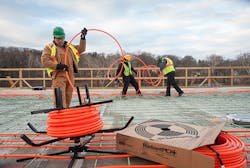WellSpan York Hospital launches radiant heated helipad
YORK, PA. — For many people when asked to name the earliest example of airborne medevac, the TV show M*A*S*H, set in the time of the Korean War, comes to mind.
If you’re among them, you may be surprised to learn the early 1950s timeframe is nearly a century too late. The earliest recorded use of air transport to get trauma victims to medical treatment occurred in 1870, by means of hot air balloons, during the siege of Paris in the Franco-Prussian War.
We’ve come a long way. Today, medevac helicopters have twin jet engines, terrain awareness systems, on-board weather radar, night vision technology and a plethora of life saving, high-tech medical equipment.
For the birds
WellSpan York Hospital, located in south central Pennsylvania, is one of the only Level 1 regional resource trauma centers in the surrounding counties.
The hospital built a new, cutting-edge helipad as part of an ongoing $50 million modernization of its emergency department, improving the hospital’s ability to administer advanced, life-saving specialty care to the region’s sickest and most seriously injured patients.
The new helipad adds yet another measure of sophisticated technology to combat one of the last remaining obstacles to safe air transport of patients for medical care: winter weather. Ice and snow accumulations on flat helicopter pads can pose great risk to airborne patients and those flying the craft as well.
“There’s an art to maintaining just the right degree of heat within a concrete helicopter pad to ensure that it’s free of ice and snow, which can temporarily blind pilots at a time when they’re most vulnerable,” said Dave Yates, president of York, PA-based F. W. Behler, Inc.
The hospital’s elevated helicopter pad is 34 feet off the ground and measures 7,200-sq.ft. – more than 3,000-sq.ft. larger than the hospital’s old helipad. The early pad required larger "birds" to land at an alternate location, over a half-mile away, where ambulances would meet them to complete the patient’s transport to the hospital.
“In trauma care, every second counts, and this helipad will enable us to provide care even sooner to our most seriously injured patients,” said Keith Noll, president of WellSpan York Hospital and senior vice president of WellSpan Health.
Three primary aeromedical systems provide helicopter transport to York Hospital. The hospital received 190 trauma patients by helicopter last year.
Winters in Pennsylvania are a force to be reckoned with. Raw, wet and cold conditions, with wind chills that can drop temps into the double-digit negatives, make the perfect recipe for piles of snow and treacherous ice.
Maintaining York Hospital’s new helipad in the winter months is now simple, thanks to its automatic snowmelt system with three miles of snowmelt tubing installed beneath the surface to keep snow and ice from accumulating.
One of the oldest mechanical contracting firms in the area, James Craft & Son, founded in 1900, is the lead mechanical contracting firm for the ongoing HVAC and plumbing renovations at York Hospital. The company installed the steam, condensate, heat exchangers, pumps and distribution piping to all manifolds.
Jeff Ream, the project manager, chose to subcontract the helipad project to Yates’ firm, well-recognized regionally for their hydronic, radiant heat and snowmelt expertise.
F.W. Behler, Inc. is the other oldest mechanical contracting firm in the area (also founded in 1900), and under Yates’ guidance, the firm has undertaken hundreds of radiant heat and snowmelt jobs through the years.
At the hospital, the project called for radiant snowmelt not only under the helipad, but also for an access road that was built after the old helipad was demolished.
“Operation Helipad” required Yates and his crew to get the new launch pad up and running in the coldest of winter months. In fact the winter of 2014/2015 — when they needed to carefully monitor post-install surface temperatures for the first time — was a record-breaking winter for low temps and snowfall.
“We’ll never forget some of those high-stress days when no matter what we did, we couldn’t stay warm,” said Yates. “Big jugs of coffee, thermal socks, long underwear, down jackets and multi-layering were no match for those winter conditions.
“We knew from the outset, with work that began in the fall, that the first, most important part was to have a safe place for the helicopters to land as winter approached,” said Yates.
More than 16,000 lineal feet of ¾-in.Watts Radiant RadiantPEX+ tubing was installed before the helipad’s cement surface was poured. A glycol mix solution runs through the radiant tubing to provide hydronic snow melting.
The pad’s design included several areas that would not have any tubing — as they were left open to the space below. This would ensure that in case of a crash landing or ruptured fuel tank, the fuel could drain away, avoiding an explosion.
“The helipad juts out from the side of the hospital,” continued Yates. “Its nearly 40-foot elevation means that it’s exposed to the wind and weather, which meant that snow and ice were sure to collect there if not for the warmth within the pad.
“The biggest challenge was wrestling with ¾-in. RadiantPEX+ in subzero weather,” continued Yates.
Yates and his crew found the formula for getting the job done quickly was to wire the tubing to rebar. This required three people — one person to lay the tubing out, one to wire it to the rebar and one to stand on the cold-hardened tubing. They used a motorized wire tie tool to save time, which performed triple wrap twists and cutoffs in less than a second.
“One of the fun parts of installing the snowmelt was the audience we had,” said Yates. “The Watts tubing is bright orange. We were installing it right outside of the hospital with airborne snow swirling all around us. We could glance up at any time and see lots of people from different windows and floors watching what we were doing. Some had binoculars, others took pictures.”
“Another design challenge was created by the manifolds for the helipad, which needed to be installed inside of the loop area. Ordinarily manifolds are off to the side in snow melting systems and termination points come straight out,” explained Yates.
Because of the bump-out areas for sidewalks around the pad and certain areas not getting snowmelt for emergency fuel drainage, the tubing had to be installed, and terminated, in different angles. At times, Yates only had five inches of space to work with.
Where the hospital’s old off-site helipad used to be, a new entrance and access road are being built, completely heated with snowmelt. The access road won’t be complete until later, because it needs to be accessible at all times — it has to be built in two phases. Phase one of the new access road is complete, along with the completion of a new 12-rig ambulance bay, completely heated with snowmelt.
In all, eleven miles of ¾-in. Watts Radiant RadiantPEX+ with the same 50% glycol mix will have been installed during both phases of the access road and the ambulance bay.
That’s a lot of work, and PEX, and glycol solution. But the team was equally tough — just tough enough to battle the worst that Mother Nature could pitch at them, in a wintry tantrum.
“The hospital is now entering the system’s second year of operation,” said Yates. “But this winter, as we complete the last, remaining few miles of PEX installation, we get satisfaction when we see a bird coming in for landing, knowing that the new helipad will provide a safe and swift landing and the patient on board is about to receive the best care possible.”
“The ‘birds’ come in swift and safe,” added Yates. “With each, another patient has a much better chance of living a longer, healthier life. You can’t ask for much more than that.”





